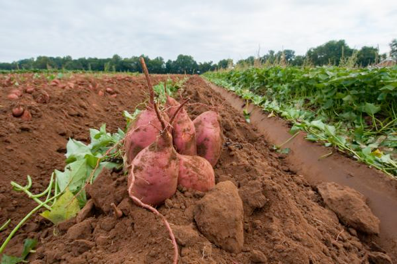North Carolina Sweet Potatoes
go.ncsu.edu/readext?500467
en Español / em Português
El inglés es el idioma de control de esta página. En la medida en que haya algún conflicto entre la traducción al inglés y la traducción, el inglés prevalece.
Al hacer clic en el enlace de traducción se activa un servicio de traducción gratuito para convertir la página al español. Al igual que con cualquier traducción por Internet, la conversión no es sensible al contexto y puede que no traduzca el texto en su significado original. NC State Extension no garantiza la exactitud del texto traducido. Por favor, tenga en cuenta que algunas aplicaciones y/o servicios pueden no funcionar como se espera cuando se traducen.
Português
Inglês é o idioma de controle desta página. Na medida que haja algum conflito entre o texto original em Inglês e a tradução, o Inglês prevalece.
Ao clicar no link de tradução, um serviço gratuito de tradução será ativado para converter a página para o Português. Como em qualquer tradução pela internet, a conversão não é sensivel ao contexto e pode não ocorrer a tradução para o significado orginal. O serviço de Extensão da Carolina do Norte (NC State Extension) não garante a exatidão do texto traduzido. Por favor, observe que algumas funções ou serviços podem não funcionar como esperado após a tradução.
English
English is the controlling language of this page. To the extent there is any conflict between the English text and the translation, English controls.
Clicking on the translation link activates a free translation service to convert the page to Spanish. As with any Internet translation, the conversion is not context-sensitive and may not translate the text to its original meaning. NC State Extension does not guarantee the accuracy of the translated text. Please note that some applications and/or services may not function as expected when translated.
Collapse ▲Do you know which vegetable is our official state vegetable? It’s the sweet potato. NC is the #1 producer of sweet potatoes in the us. Today more than 40% of the national supply of sweet potatoes comes from NC. According to the USDA, North Carolina harvested nearly 95,000 acres of sweet potatoes in 2016, nearly 30,000 more acres than California, Louisiana and Mississippi combined.
Commonly thought of as a winter comfort food, sweet potatoes are actually available year-round. They’re not just for thanksgiving’s sweet potato pie anymore. High in vitamins A, C Manganese, antioxidants, fiber and low in fat paired with a low glycemic index, these large, starchy, sweet-tasting tuberous roots can be fixed up in a variety of ways. Sweet potatoes are now found in frozen and microwave products and even sweet potato chips, unlike before where all sweet potato foods were from the fresh product either baked or candied. Even the young leaves and shoots are sometimes eaten as greens. There are hundreds of types of sweet potatoes ranging from white and mild to deep red and super sweet. We’re familiar with varieties such as the Evangeline, Bayou Belle, Beauregard, Bonita, Covington, NC05-198, and Orleans just to name a few.
The Covington variety of sweet potato has rose colored skin and super-sweet orange flesh. It’s a favorite for mashing or roasting. Eat it whole with your favorite toppings or cut into wedges and bake as a side dish.
 The O’Henry sweet potato has a pale copper skin, almost like a potato with sweet white flesh ideal for soups and stews, but sweet potatoes and white potatoes aren’t even in the same family of plants. Sweet potatoes are in the same family as the morning glory flowering plant and the “Irish” potato is in the nightshade family, along with tomatoes, peppers and eggplants. Japanese sweet potatoes, a favorite in Asian and Hispanic cultures have red skin and dry, white flesh. They’re often roasted with other root vegetables for colorful side dishes.
The O’Henry sweet potato has a pale copper skin, almost like a potato with sweet white flesh ideal for soups and stews, but sweet potatoes and white potatoes aren’t even in the same family of plants. Sweet potatoes are in the same family as the morning glory flowering plant and the “Irish” potato is in the nightshade family, along with tomatoes, peppers and eggplants. Japanese sweet potatoes, a favorite in Asian and Hispanic cultures have red skin and dry, white flesh. They’re often roasted with other root vegetables for colorful side dishes.
Planting takes place throughout April, May, and June. It takes about 120 days from transplanting to harvest in late August through early November. Sweet potatoes grow best in loamy soils. The best soil types are well-drained, fine sandy, or clay loams. Light, loamy soils usually result in roots with better shapes than those grown in heavy or clay soils, which result in rough, irregular roots. High (more than two percent) organic soils also reduce production.
Some sweet potatoes are washed and graded for sale as soon as they are dug. This is called the “green crop.” Others are cured and stored. “Cured” is the process of allowing the skin on the potatoes to tighten, the starches to turn to sugars, and the scuffs to heal. “Cured” potatoes are sweeter than “green stock” and are more resistant to skinning. During the storage process temperatures are very important. Long-term storage is kept at 55 to 60 degrees F with 85 % relative humidity. Properly cured and stored sweet potatoes can be held up to 12 months with little reduction in quality. That’s why the highly nutritious sweet potatoes were a major factor in keeping hunger at bay for the early colonists, and during the Revolutionary War, Civil War and the Great Depression.
Don’t refrigerate them unless they are cooked. Cold temperatures can cause them to become bitter and develop a hard center core. Store them in a cool, dry place and use them within a week or two, then get some more!
Minda Daughtry is Horticulture Agent for North Carolina Cooperative Extension in Lee County.




